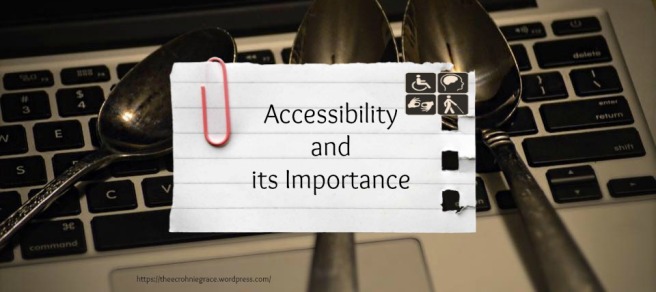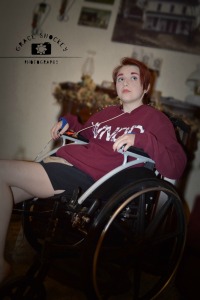
[Image shows three spoons laying on a laptop keyboard, over it, is a clipart of a torn paper with a red paper clip. On the paper in black font reads “Accessibility and its Importance” and includes the symbols for wheelchair user, neurodivergent/learning disabilities symbol of a profile of a face with a brain, interpreter symbol which is the sign for interpreter, and the symbol for the blind of a stick man with a white walking stick. At the bottom of the border is the website URL for my blog “TheeCrohnieGrace”]
Spoiler alert, the world is not as accessible as everyone believes. I have had people tell me, “The law makes it so that every place has to be accessible.” But having a wheelchair ramp and wide door way does not make the world accessible to the disabled.
All houses are built typically with stairs, you have to pay out of your own money (most of the time) if you want a wheelchair ramp. Super accessible right? For someone to walk over a curb may be easy, but imagine that with a cane and limited balance or a wheelchair.
Most doors are not automatic. Not a problem for some people, but when I have a cane in one hand and my feeding back in the other, opening doors presents a problem. Now imagine that but from a wheelchair, I may be able to open the door slightly, but not necessarily enough to get me inside.
“But surely some nice saint-like abled bodied person will hold the door open for you because they feel bad?” Says the world. Except, more often times than not it is abled-bodied people who take our accommodations. The world is designed for those who are not disabled. And yet, for some reason, they feel the need to take disabled parking, block ramps, sit in disabled seating, use the disabled stalls in the restroom when there were two other bathrooms completely open. For a world of people who love to use us in their inspiration porn (Click to learn more) or pity us to make them feel better about themselves, they, for the most part do not care about our needs. Which, are not “Special Needs”, they are human needs.
“But why should the world cater to a minority, the majority of the world doesn’t need these things so why should we have to change?” Well nearly 1 in 5 people in the United States has a disability. That is about 56.7 million people. So that’s no small number. In fact, people with disabilities are the largest minority in the world, and often the most left out when it comes to discussions, even about us.
“But the ADA covers everything, so legally…” I going to stop you right there, cause legally we aren’t allowed to murder people but it happens everyday. Those who cannot typically afford to pay their own medical bills, also cannot afford a lawyer to sue a place for not following the ADA’s laws (Click to view the laws). Which means that things are often ignored.
You’re not supposed to be able to not hire someone simply because their disabled, or fire them simply because they are disabled. So jobs will find a million and one other reasons as to why you aren’t fit for the job, and this isn’t even manual labor. This happens in offices and various other job departments.
Transportation is supposed to be accessible according to the ADA Title II on public transportation, so they have ramps and disabled seating, which gets taken by the college frat boy who got drunk the night before and is sprawled out over the seat. I wish I could make up these stories.
Did you know that all places are legally required to have interpreters ready and available for those who need them? Many places ignore this so that they do not have to pay an interpreter, leaving it up to the person who needs an interpreter to find and pay themselves.
But this is not the only issue, accessibility takes many forms. Annie Elainey, a disabled youtuber, talks about accessibility frequently. Not just for the physically disabled, but for the blind, deaf, and neurodivergent. “Accessibility means different things to different people.” She says, which is absolutely true.
In her video “What is Accessibility?” (Click to view the video | CC Available), Annie Elainey, Ricki Poytner, James Rath, and Emily discuss what accessibility means to different people. From being a wheelchair user, to being deaf, to being blind, and autistic. Each person has different basic human needs to make the world accessible for them as it is for everyone else.
So what are some of the things they discussed in the video in regards to accessibility?
For Annie, it is making sure there is enough space for wheelchairs everywhere, in hallways, in between racks at stores, at movie theaters, in bathrooms, and making sure that the ramps are even accessible. They are not always.
For James, it is having captions on videos and images, and having font that is large enough to read, or that can be copy and pasted on a site for easier access for text-to-speech programs.
To Emily, it is having sensory friendly areas to avoid chances of over stimulation, having disability trained staff.
For Ricki, it means having captions on videos (and not the terrible auto captions done by youtube) so that she can see what is being said, since she cannot hear it.
To see more, watch her video.
When I go to the bathroom, and see two open stalls that I can barely fit in, and one abled bodied waitress in the disabled stall who I went to high school with, so I’m forced to squeeze into a tiny stall with my feeding pump backpack on the bathroom floor, trying to find a place to set my cane so I can empty my ostomy, and then have the waitress ask me “How are you doing?” when I try to squeeze back out. That is not accessible.
When I am at a restaurant or event and the tables are so close together that I almost trip trying to navigate my way through, that’s not accessible.
When I go to a movie, and abled bodied people steal the disabled seating because there is only one of them and they don’t want to sit next to others, so I am stuck in the second row where people let out rude sighs when they have to take their feet off the headrest for me to squeeze through the aisle that hardly fits me and cane, and would never fit a wheelchair. That is not accessible.
Not to mention the inability to process any of the movie that close up because of the fast moving colors, the only thing I had going for me is I could hear the dialogue. And for someone who cannot hear, only recently did they make it accessible for those who need captions.
When the world around you is like an obstacle course. That’s not accessible. And that needs to be changed.

